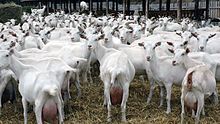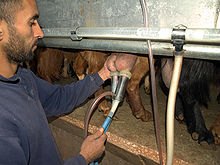**Goat Milk Products:**
– Pélardon is a type of cheese made from goat milk.
– Goat milk is processed into cheese, butter, ice cream, yogurt, and cajeta.
– Goat cheese is known as fromage de chèvre in France.
– Varieties of goat cheese include Rocamadour and Montrachet.
– Goat butter is white due to the conversion of beta-carotene to colorless vitamin A.
**Nutritional Aspects:**
– Goat milk protein is suitable for infant and follow-on formulas.
– Goat milk-based infant formulas are popular globally.
– AAP supports goat infant formula for normal growth in infants.
– Goat milk has different nutritional values compared to cow and human milk.
– Breast milk is the best nutrition for infants.
**Composition and Properties:**
– Goat milk has different fat, protein, and lactose content compared to cow and human milk.
– The composition varies by breed and lactation period.
– Goat milk has less cholesterol compared to cow milk.
– Specific nutrients in goat milk may not meet infants’ nutritional needs.
– Whole goat milk is not recommended for infants due to digestive issues.
**Health Benefits and Culinary Uses:**
– High in nutrients like calcium, protein, and vitamins.
– Easier to digest than cow’s milk.
– May help improve skin health.
– Used in making cheese, yogurt, and ice cream.
– Adds a unique flavor to dishes.
**Environmental Impact and Sustainability:**
– Requires less water and land compared to cow farming.
– Produces less methane emissions.
– Can thrive in diverse climates.
– Sustainable alternative to cow milk.
– Promotes biodiversity and conservation efforts.
Goat milk is the milk of domestic goats. Goats produce about 2% of the world's total annual milk supply. Some goats are bred specifically for milk. Goat milk naturally has small, well-emulsified fat globules, which means the cream will stay in suspension for a longer period of time than cow's milk; therefore, it does not need to be homogenized. Eventually, the cream will rise to the top over a period of a few days. If the milk is to be used to make cheese, homogenization is not recommended, as this changes the structure of the milk, affecting the culture's ability to coagulate the milk and the final quality and yield of cheese.




Dairy goats in their prime (generally around the third or fourth lactation cycle) average—2.7 to 3.6 kg (6 to 8 lb)—of milk production daily—roughly 2.8 to 3.8 L (3 to 4 U.S. qt)—during a ten-month lactation, producing more just after freshening and gradually dropping in production toward the end of their lactation. The milk generally averages 3.5% butterfat.
